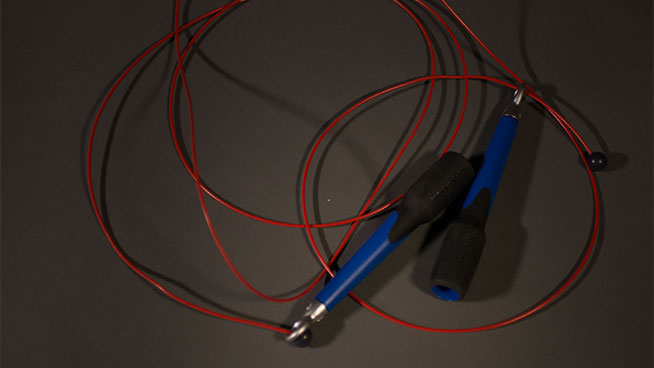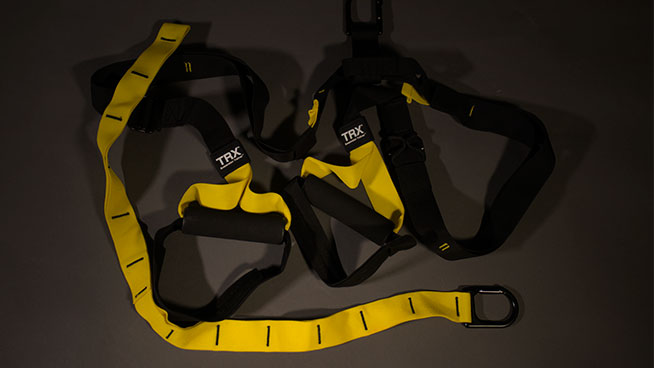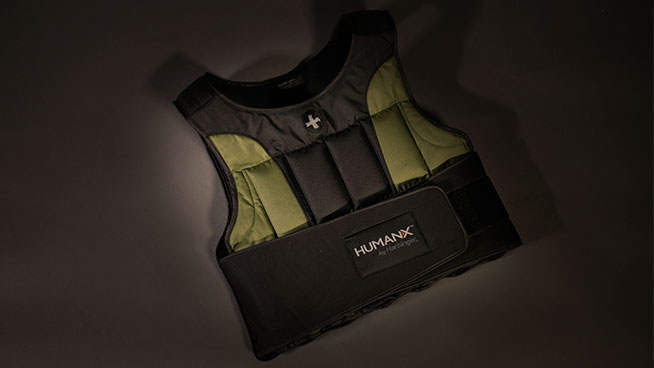SURVIVING SEALFIT: Inside the Devil’s Backpack: The Only 5 Things You Need to get a Hellishly Hard Workout Anywhere
![]()
When you’re following a Navy SEAL-inspired training program, nothing becomes more clear than the fact that you don’t need a lot of stuff to get an incredible workout. You don’t need a gym with high-tech equipment. You don’t even need a gym. In fact, after several months of doing SEAL-style workouts, I’ve discovered that everything I need to get a super-intense workout can fit inside a backpack.
Before I go on, I should make the obvious disclaimer that you can create tough workouts with no equipment whatsoever. Bodyweight exercises can be hella-hard, and they’re more than capable of sending your heart rate through the ceiling. Don’t believe me? Do 100 Burpees in a row, then try to tell a friend how you feel in one unbroken, non-gasping sentence. Ten bucks says you can’t.
RELATED: See the World’s Hardest Workout
The only trouble is that bodyweight workouts can also get boring. And repetitive. And boring. Did I mention boring? I did. That’s what happens when you do the same thing over and over, like Push-Ups and Sit-Ups. Your mind starts to drift. Adding some equipment helps keep your workouts fresh and interesting.
“Sure, having a stocked gym is great. But really, you don’t need much,” says SEALFIT trainer Will Talbott. He’s the guy who’s been guiding me as I prepare for the SEALFIT 20X Challenge, an intense, daylong boot camp run by current and former Navy SEALS that I will attempt in June. “When you’re traveling, for example, just bring a jump rope and a ruck sack. Need weight for the ruck? Buy water jugs at the grocery store.”
RELATED: 3 Ways SEAL-Style Workouts Change Your Life
My job requires me to travel from time to time, so the minimalist approach definitely appealed to me. But I’m not so minimalist that I’m content to lug around a bag full of water jugs from place to place. Variety is the spice of life after all. Through some experimentation, I’ve been able to create wickedly difficult full-body workouts using just five implements. Conveniently, they fit inside a ruck sack—indeed (spoiler alert!), one of the items is the bag itself, which I’ve nicknamed “The Devil’s Backpack” after hours of carrying it around on long hikes. Here’s what else is inside.
Jump Rope

You probably saw this one coming after reading Will’s quote. What I love about jumping rope is that it’s the only exercise that’s arguably even more accessible than running. Say you travel to a totally unfamiliar place, and the area around your hotel is either confusing, sketchy, or congested with traffic. With a jump rope, you can get an awesome cardio workout without leaving your room. For a cardio challenge, try jumping rope for the same length of time you’d run. Work in a strength component by stopping to do Push-Ups every five minutes. Jumping rope for a few minutes is also a great way to warm up for a workout.
TRX

The TRX ($200, trxtraining.com) is a suspension trainer, which is the complicated way of saying “two heavy duty straps you can fasten to a doorway.” This simple-looking contraption opens up almost limitless training possibilities. Its inventors have developed full-body training plans that use just this one piece of equipment.
Performing exercises on a TRX is like going to a two-for-one sale, since your muscles have to work to stay stable at the same they try to execute the move. (The TRX Crunch, which requires you to keep your feet stable against gravity as you attempt to lift your knees to your chest, is an exceptionally illustrative example.)
But the big win for me is that TRX is a great training tool for people who suck at Pull-Ups, as I do. Although you can do Push-Ups anywhere, it’s a lot harder to work those “pull” muscles in your back without equipment. The TRX solves that problem for you.
The Ultimate Sandbag

Here’s another item you can use in lots of different ways.
Josh Henkin, inventor of the Ultimate Sandbag ($70-$160, ultimatesandbagtraining.com), has created his own system around it, which he calls “Dynamic Variable Resistance Training,” or DVRT. The key word here is “variable.” Training with a sandbag is tough, because the weight shifts around on you as you lift it. You’re constantly making adjustments as you move. However, what’s really great about the Ultimate Sandbag is that you can fill it with as much or as little resistance as you want, and you can take it anywhere. If you’re on a work trip that has you flying to several places, you won’t need to buy water jugs in every town. Just fill up the sandbag when you arrive, and empty it when it’s time to leave.
Weighted Vest

A weighted vest is great because it’s capable of making every exercise more difficult—even walking. Just walking around with a 20-pound vest places a sweat-inducing demand on your body. The extra weight makes movement far more difficult. (It also makes you quickly realize how much additional stress you put on your body when you’re overweight.)
The vest is an especially good idea when you’re trying to build strength and endurance with bodyweight exercises like Push-Ups and Sit-Ups—which I need to do since the SEALFIT 20X Challenge requires all participants to hit a target number of Push-Ups and Pull-Ups within a two-minute time limit. Since I started wearing the HumanX 20-Pound Weight Vest ($80, amazon.com) during workouts, my scores in those exercises when I’m “slick” (SEALFIT’s word for workouts performed without a weighted vest) have improved.
One might argue that this item is redundant with the backpack. Wearing a backpack full of water would do the same thing. However, I prefer the weighted vest because it’s compact, streamlined, and spreads the resistance more evenly than a backpack.
Backpack

SEALFIT’s workouts call for a lot of rucking, or long marches with a heavy backpack (the prescribed weight is 35 pounds.) Typically, I try to fill one of the sandbags with that much weight in sand, then I place the sandbag inside the backpack. From there, you can just walk, or you can mix it up with some strength work. Talbott suggests the following: Find a flight of stairs and see how many times you can get up and down them in 30 minutes while performing 20 Overhead Squats (hold the backpack above your head with your arms fully extended) at the top and 20 Weighted Push-Ups (wearing the backpack) at the bottom.
If that’s not enough torture for you, Talbott says you could jump rope before and after the stair workout. He suggests 100 Double-Unders—those ballistic jump-rope moves where a highly skilled person gets the rope to go underneath their feet twice on each jump—but since I can perform exactly zero of those, I’m going to pretend I didn’t hear him. Still not enough? You could also find a park bench and do Step-Ups. “The possibilities are really endless,” Talbott says.
Related Posts:
SURVIVING SEALFIT, part 1: What Happened When a Regular Guy Tried to Train Like a Navy SEAL
SURVIVING SEALFIT, part 2: 3 Ways SEAL-Style Workouts Change Your Life
SURVIVING SEALFIT, part 3: The World’s Hardest Workout Has a Ridiculous Name
SURVIVING SEALFIT, part 5: How Not to Hurt Yourself (Like I Did)
SURVIVING SEALFIT, part 6: Finding the Silver Lining
SURVIVING SEALFIT, part 7: The Question That Tells You Whether You’ll Succeed
SURVIVING SEALFIT, part 8: Meet 3 Guys Who Might Kill Me
SURVIVING SEALFIT, part 9: The Dress Rehearsal
SURVIVING SEALFIT, part 10: What a SEALFIT 20X Challenge is REALLY Like
*****
This is the fourth installment of SURVIVING SEALFIT, STACK Executive Editor Brian Sabin‘s account of his quest to reach elite military grade fitness, take a SEALFIT 20X Challenge and (hopefully) live to tell about it. He’ll publish weekly accounts of his ups and downs here at STACK.com. You can also find him posting daily updates on Twitter and Google Plus.
RECOMMENDED FOR YOU
MOST POPULAR
SURVIVING SEALFIT: Inside the Devil’s Backpack: The Only 5 Things You Need to get a Hellishly Hard Workout Anywhere
![]()
When you’re following a Navy SEAL-inspired training program, nothing becomes more clear than the fact that you don’t need a lot of stuff to get an incredible workout. You don’t need a gym with high-tech equipment. You don’t even need a gym. In fact, after several months of doing SEAL-style workouts, I’ve discovered that everything I need to get a super-intense workout can fit inside a backpack.
Before I go on, I should make the obvious disclaimer that you can create tough workouts with no equipment whatsoever. Bodyweight exercises can be hella-hard, and they’re more than capable of sending your heart rate through the ceiling. Don’t believe me? Do 100 Burpees in a row, then try to tell a friend how you feel in one unbroken, non-gasping sentence. Ten bucks says you can’t.
RELATED: See the World’s Hardest Workout
The only trouble is that bodyweight workouts can also get boring. And repetitive. And boring. Did I mention boring? I did. That’s what happens when you do the same thing over and over, like Push-Ups and Sit-Ups. Your mind starts to drift. Adding some equipment helps keep your workouts fresh and interesting.
“Sure, having a stocked gym is great. But really, you don’t need much,” says SEALFIT trainer Will Talbott. He’s the guy who’s been guiding me as I prepare for the SEALFIT 20X Challenge, an intense, daylong boot camp run by current and former Navy SEALS that I will attempt in June. “When you’re traveling, for example, just bring a jump rope and a ruck sack. Need weight for the ruck? Buy water jugs at the grocery store.”
RELATED: 3 Ways SEAL-Style Workouts Change Your Life
My job requires me to travel from time to time, so the minimalist approach definitely appealed to me. But I’m not so minimalist that I’m content to lug around a bag full of water jugs from place to place. Variety is the spice of life after all. Through some experimentation, I’ve been able to create wickedly difficult full-body workouts using just five implements. Conveniently, they fit inside a ruck sack—indeed (spoiler alert!), one of the items is the bag itself, which I’ve nicknamed “The Devil’s Backpack” after hours of carrying it around on long hikes. Here’s what else is inside.
Jump Rope

You probably saw this one coming after reading Will’s quote. What I love about jumping rope is that it’s the only exercise that’s arguably even more accessible than running. Say you travel to a totally unfamiliar place, and the area around your hotel is either confusing, sketchy, or congested with traffic. With a jump rope, you can get an awesome cardio workout without leaving your room. For a cardio challenge, try jumping rope for the same length of time you’d run. Work in a strength component by stopping to do Push-Ups every five minutes. Jumping rope for a few minutes is also a great way to warm up for a workout.
TRX

The TRX ($200, trxtraining.com) is a suspension trainer, which is the complicated way of saying “two heavy duty straps you can fasten to a doorway.” This simple-looking contraption opens up almost limitless training possibilities. Its inventors have developed full-body training plans that use just this one piece of equipment.
Performing exercises on a TRX is like going to a two-for-one sale, since your muscles have to work to stay stable at the same they try to execute the move. (The TRX Crunch, which requires you to keep your feet stable against gravity as you attempt to lift your knees to your chest, is an exceptionally illustrative example.)
But the big win for me is that TRX is a great training tool for people who suck at Pull-Ups, as I do. Although you can do Push-Ups anywhere, it’s a lot harder to work those “pull” muscles in your back without equipment. The TRX solves that problem for you.
The Ultimate Sandbag

Here’s another item you can use in lots of different ways.
Josh Henkin, inventor of the Ultimate Sandbag ($70-$160, ultimatesandbagtraining.com), has created his own system around it, which he calls “Dynamic Variable Resistance Training,” or DVRT. The key word here is “variable.” Training with a sandbag is tough, because the weight shifts around on you as you lift it. You’re constantly making adjustments as you move. However, what’s really great about the Ultimate Sandbag is that you can fill it with as much or as little resistance as you want, and you can take it anywhere. If you’re on a work trip that has you flying to several places, you won’t need to buy water jugs in every town. Just fill up the sandbag when you arrive, and empty it when it’s time to leave.
Weighted Vest

A weighted vest is great because it’s capable of making every exercise more difficult—even walking. Just walking around with a 20-pound vest places a sweat-inducing demand on your body. The extra weight makes movement far more difficult. (It also makes you quickly realize how much additional stress you put on your body when you’re overweight.)
The vest is an especially good idea when you’re trying to build strength and endurance with bodyweight exercises like Push-Ups and Sit-Ups—which I need to do since the SEALFIT 20X Challenge requires all participants to hit a target number of Push-Ups and Pull-Ups within a two-minute time limit. Since I started wearing the HumanX 20-Pound Weight Vest ($80, amazon.com) during workouts, my scores in those exercises when I’m “slick” (SEALFIT’s word for workouts performed without a weighted vest) have improved.
One might argue that this item is redundant with the backpack. Wearing a backpack full of water would do the same thing. However, I prefer the weighted vest because it’s compact, streamlined, and spreads the resistance more evenly than a backpack.
Backpack

SEALFIT’s workouts call for a lot of rucking, or long marches with a heavy backpack (the prescribed weight is 35 pounds.) Typically, I try to fill one of the sandbags with that much weight in sand, then I place the sandbag inside the backpack. From there, you can just walk, or you can mix it up with some strength work. Talbott suggests the following: Find a flight of stairs and see how many times you can get up and down them in 30 minutes while performing 20 Overhead Squats (hold the backpack above your head with your arms fully extended) at the top and 20 Weighted Push-Ups (wearing the backpack) at the bottom.
If that’s not enough torture for you, Talbott says you could jump rope before and after the stair workout. He suggests 100 Double-Unders—those ballistic jump-rope moves where a highly skilled person gets the rope to go underneath their feet twice on each jump—but since I can perform exactly zero of those, I’m going to pretend I didn’t hear him. Still not enough? You could also find a park bench and do Step-Ups. “The possibilities are really endless,” Talbott says.
Related Posts:
SURVIVING SEALFIT, part 1: What Happened When a Regular Guy Tried to Train Like a Navy SEAL
SURVIVING SEALFIT, part 2: 3 Ways SEAL-Style Workouts Change Your Life
SURVIVING SEALFIT, part 3: The World’s Hardest Workout Has a Ridiculous Name
SURVIVING SEALFIT, part 5: How Not to Hurt Yourself (Like I Did)
SURVIVING SEALFIT, part 6: Finding the Silver Lining
SURVIVING SEALFIT, part 7: The Question That Tells You Whether You’ll Succeed
SURVIVING SEALFIT, part 8: Meet 3 Guys Who Might Kill Me
SURVIVING SEALFIT, part 9: The Dress Rehearsal
SURVIVING SEALFIT, part 10: What a SEALFIT 20X Challenge is REALLY Like
*****
This is the fourth installment of SURVIVING SEALFIT, STACK Executive Editor Brian Sabin‘s account of his quest to reach elite military grade fitness, take a SEALFIT 20X Challenge and (hopefully) live to tell about it. He’ll publish weekly accounts of his ups and downs here at STACK.com. You can also find him posting daily updates on Twitter and Google Plus.











